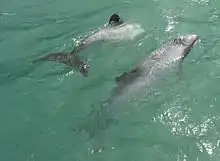Mammals of New Zealand
Prior to human settlement, the mammals of New Zealand consisted entirely of several species of bat, and several dozen marine mammal species. Far earlier, during the Miocene, at least one "archaic" terrestrial mammal species is known to have existed, the Saint Bathans mammal. The Māori brought the kurī (Polynesian dog) and kiore (Polynesian rat) in about 1250 CE,[1] and Europeans from 1769 onwards brought the pig, mice, two additional species of rats, weasels, stoats, ferrets and possums and many other species, some of which cause conservation problems for indigenous species.

Indigenous species
- Three recent species of bats: the long-tailed, short-tailed and lesser short-tailed. Though they varied in range, Holocene fossils of all three species have been found near Cape Reinga / Te Rerenga Wairua at the far north of the North Island.[2] The Miocene Saint Bathans Fauna showcases a considerably higher diversity of at least four mystacine species, a vesper bat and several incertae sedis taxa.[3]
- Several dozen species of whales and dolphins including the small endemic Hector's dolphin
- Seven species of seal or sea lion
- The Miocene St Bathans mammal.
Conservation status
- The New Zealand lesser short-tailed bat is considered endangered (EN), whereas the New Zealand greater short-tailed bat is presumed extinct (EX) with the last sighting being in 1967. The New Zealand long-tailed bat is considered to be critically endangered (CR).
- The sei, fin and blue whales are all endangered (EN), as is the Hector's dolphin which is found only in New Zealand waters.
The Department of Conservation rank priorities for conservation with the New Zealand Threat Classification System.
Introduced species
Māori introduced two species kurī (dog) and the kiore (Polynesian rat) and European settlers introduced many other mammal species.
| Species | year of introduction[4] | Further information |
|---|---|---|
| Bennett's Wallaby | ||
| Black rat | ||
| Cat | as early as 1820 | Cats in New Zealand |
| Cattle | 1814 | |
| Chamois | 1907 | |
| Common brushtail possum | 1837 | Common brushtail possum in New Zealand |
| Dama Wallaby | ||
| Elk (wapiti) | ||
| European hedgehog | 1870 | Hedgehogs in New Zealand |
| Fallow deer | 1864 | |
| Ferret | 1879 | |
| Goat | late 1700s | |
| Hare | 1851 | |
| Himalayan tahr | ||
| House mouse | ||
| Kiore | 1250 | |
| Kurī | 1250 | |
| Moose | 1900, 1910 | Moose - New Zealand |
| Norway rat | 1800s | |
| Pig | 1773 | |
| Rabbit | 1838 | |
| Red deer | from 1851 | |
| Sambar deer | 1875-76 | |
| Sheep | 1773 | |
| Stoat | Stoats in New Zealand | |
| Wallaby | ||
| Weasel | ||
| White-tailed deer |
Agricultural animals such as cattle and sheep were also introduced, as well as alpacas and llamas.
See also
References
- Lowe, David J. (November 2008). "Polynesian settlement of New Zealand and the impacts of volcanism on early Maori society: an update" (PDF). Guidebook for Pre-conference North Island Field Trip A1 'Ashes and Issues': 142. ISBN 978-0-473-14476-0. Retrieved 2010-01-18.
- Gill, B.J. (2002). "RECORDS OF BATS (MAMMALIA: CHIROPTERA) FROM LATE HOLOCENE DUNE-SANDS AT TE WERAHI BEACH, NORTHLAND, NEW ZEALAND". Records of the Auckland Museum. 39: 45–47. ISSN 1174-9202.
- Worthy, Trevor; Hand, SJ; Worthy, TH; Archer, M; Worthy, JP; Tennyson, AJD; Scofield, RP (2013). "Miocene mystacinids (Chiroptera, Noctilionoidea) indicate a long history for endemic bats in New Zealand". Journal of Vertebrate Paleontology 33 (6): 1442-1448.
- King, Carolyn M. (1985). Immigrant Killers: Introduced Predators and the Conservation of Birds in New Zealand. Auckland: Oxford University Press. ISBN 978-0-19-558115-7.
Further reading
- King, Carolyn M. (1995). The Handbook of New Zealand Mammals. Oxford University Press, USA. ISBN 0-19-558320-5.
